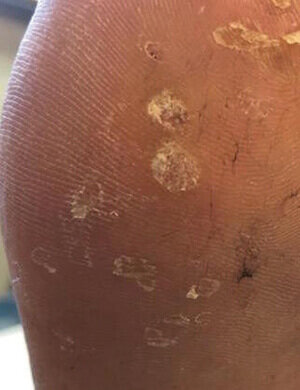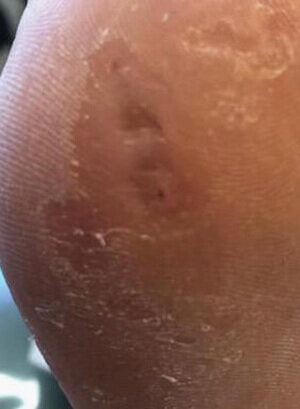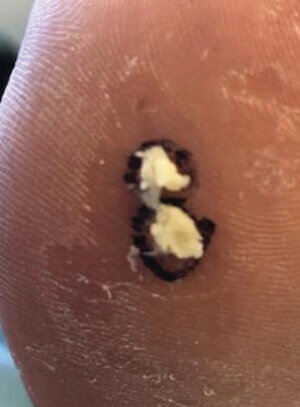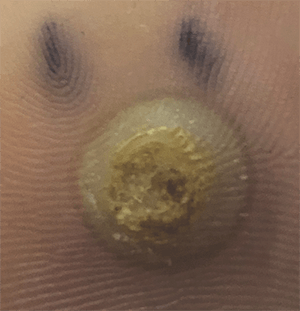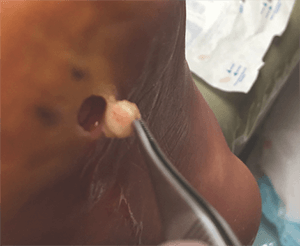A Stepwise Approach For Treating Plantar Warts In Children
Plantar warts can be challenging to treat in any patient. However, when factoring in complexities associated with a pediatric patient, the provider must carefully consider the best options for each case. Accordingly, the authors share an evidence- and experience-based plan for treating verruca, including what to do when first, second or even third-line treatments are unsuccessful.
One of the most common reasons for a visit to a podiatrist is the treatment of plantar warts. There are more than 30 different types of verrucae. Plantar warts are usually caused by walking barefoot around a swimming pool, on the beach or outdoors where these microscopic viruses are on the ground. These skin lesions are usually painful with lateral compression, have discontinuous skin lines and punctated bleeding upon debridement.
Treatment in the pediatric patient presents additional challenges to the foot specialist as he or she needs to manage parent expectations and patient fears. Accordingly, let us take a closer look at effective treatment for these persistent skin lesions
There are three primary goals of treatment of warts in the pediatric patient, which include resolving the warts as soon as possible, minimizing pain during treatment and keeping the patient active at school or with recreational sports. Parents typically want to resolve the problem as soon as possible. However, conservative care is recommended prior to surgical excision as, in our experience, topical treatments are often very effective in combination with sharp debridement by a podiatrist. If the wart is severely painful, larger than five mm or has been present for more than six months, parents may be more anxious for a quick solution, and the clinician may need to consider surgical excision initially.
Most children will be nervous on the first visit. Conservative care with debridement and topical medication is ideal to initially relax the child, and help the patient feel more comfortable for the next visit. In our practice, we always advise the parents that if the wart is not significantly smaller after three weeks, we will consider a more aggressive topical medication or surgical excision on the next visit.
Reviewing Common Wart Treatments And Associated Concerns
In the past, we have attempted many other methods of treatment for plantar warts but they have proven to be less effective or caused other complications. Prior use of topical medications including topical salicylic acid patches, fluorouracil ointment and others revealed less than a 50 percent success rate and often required numerous sharp debridements. The use of bleomycin injections has a high success rate but the medication is very expensive, has a short shelf life and the insurance companies often do not reimburse for this fairly. In addition, the medication requires a painful injection and may require a second debridement with injectable anesthesia to resolve the verrucae. This is not recommended for children.
In our clinical experience, the use of a carbon dioxide laser is a very effective treatment but often creates a large wound, which will take over one month to completely heal. The post-op wound is often painful and may limit weightbearing for more than three weeks. It also requires an anesthetic injection for excision and may result in painful scar tissue as the depth of the laser is sometimes difficult to control. In addition, the plume of smoke during debridement may be hazardous to the doctor, even when he or she is using a mask. This method is no longer recommended.
Keys To Treatment
Step 1. Our initial treatment plan for plantar warts includes sharp debridement and the application of topical Salinocaine™ (Premier Medical) ointment. One would apply this combination of concentrated salicyclic acid 55% and ethyl aminobenzoate (Benzocaine) under occlusion with moleskin or adhesive tape. For pediatric patients, we recommend applying the ointment at home before they go to sleep and removing it in the morning. This treatment does not usually cause pain and will keep the child active during the treatment process. It may require two to three debridements to resolve the wart. I usually see the patient every two weeks until the verruca is resolved. This method works well more than 50 percent of the time in our experience and clinicians can employ this treatment concomitantly with oral zinc sulfate if multiple warts are present.
Zinc sulfate is an excellent adjunct to topical medications. We typically recommend 220 mg orally twice daily for most children (10 mg/kg up to a maximum dose of 660 mg/day). We have found zinc sulfate very helpful in patients who have multiple verrucae or warts that are multiplying. This will typically take two to three months of treatment. Unfortunately, not all children can swallow a pill nor do they always remember to take the medication.
In a randomized controlled study of 43 patients, 86.9 percent of those in the zinc-treated group had complete wart clearance in three months in comparison to zero percent in the placebo group. Researchers also determined that most of the patients were deficient in serum zinc levels prior to treatment.1,2 It is important to discuss possible side effects from zinc, which include nausea, vomiting and mild epigastric pain. Explain to patients that they can minimize side effects by taking zinc sulfate with food.
Step 2. Vircin (Pedicis) is a new treatment that has emerged in the past few years. We have experienced significant success with it and the medication is well-tolerated by children. This product has povidone iodine, salicylic acid and an immunomodulant, which has antiviral activity. The immunomodulant triggers an immune response to clear the virus and prevent recurrence. The ointment is applied two times a day and you should ask the patient to wait five minutes before putting on his or her socks, or use a hairdryer to dry it more quickly. The product is dispensed from a doctor’s office. The patient usually needs to apply it for one to two months.
Every two to three weeks, a podiatrist should perform debridement until the warts are resolved to achieve the best results. We typically recommend this if Salinocaine was ineffective after three weeks or if the child is having difficulty with the Salinocaine applications due to skin irritation or placing too much cream on the foot at night. One advantage of the topical Vircin is you do not need to occlude it with tape or moleskin, and it comes with an easy applicator at the tip of the tube.
Step 3. If the wart is persistent after the use of Salinocaine, Vircin and/or zinc sulfate, the use of topical Cantharone® Plus (CPS) (1% cantharidin, 5% podophyllotoxin, 30% salicylic acid, Dormer Labs) is recommended with occlusion. Typically, one debrides the skin growth in the office and applies Cantharone Plus under occlusion with a pressure offloading pad. This topical medication will create a blister and is sometimes very painful for the first two days if the child is walking on it. Patients with multiple warts undergoing treatment or warts in weightbearing areas may benefit from crutches.
We recommend keeping the site dry for two to three days before returning to the clinic for surgical excision under local anesthesia. If the child is extremely anxious, then he or she can undergo surgical excision in the hospital or surgery center under local anesthesia with IV-monitored anesthesia. Upon surgical excision, the medication lifts the epidermal layer of the wart and surgical debridement will determine the depth of the excision. One will clearly see the stalk of the verruca and should sharply debride it down to the base. We recommend applying phenolic acid to the base of the wart after excision to cauterize the blood vessels as well as kill any remaining microscopic cells of the benign skin neoplasm. Dressings should include an antibiotic ointment, a non-adherent dressing and gauze for padding. Typically, the post-op wound will heal in one to two weeks and the patient should be able to return to full activities two weeks after the initial treatment.
Prior studies with Cantharone Plus have showed a 95.8 percent cure rate for plantar warts at six months in 144 adults and children.3 In a study by Lopez and colleagues on 75 patients using Cantharone Plus with occlusion followed by surgical excision, 100 percent of the patients had complete resolution at six months.4 Of the 75 patients, 72 percent required one treatment and the warts of the remaining patients resolved after two treatments. Of these 75 patients, 72 percent of the warts were located in the forefoot and 17.3 percent of the warts were in the rearfoot with the remaining warts in the midfoot. 4
Step 4. In rare cases of recurrence, we recommend surgical excision with local anesthesia or with IV sedation depending upon the maturity and anxiety levels of the patient. Initially, we debride the overlying hyperkeratotic tissue down to pinpoint bleeding and incise the verruca circumferentially through the epidermis down to the basement membrane, not extending into the dermis. One often uses a curette to help completely excise the wart. Subsequent pathologic examination of the specimen can help determine the type of verruca and rule out different benign or malignant soft tissue neoplasms.
We typically apply three, 30-second applications of phenol after excision to cauterize the surgical wound and help kill any remaining microscopic viral particles. We recommend daily dressing applications. The wound may take three to four weeks to heal or more depending upon the size of the lesion as we let the wound heal by secondary intention. If the wound is larger than five mm, we may suture the wound closed.
Reviewing The Rationale For A Unique Stepwise Treatment Algorithm
When a child notices a skin lesion on the bottom of the foot, he or she will often not tell his or her parents until it becomes larger and painful. Parents will often try over-the-counter topical acid creams or patches, duct tape or other home remedies. These lesions were often thought to spontaneously resolve in more than 50 percent of cases according to the literature but we have not seen this in our offices.
Many of these home remedies have been disproven in clinical studies over the years.5,6 Many pediatricians and dermatologists use liquid nitrogen on other parts of the body, but this painful treatment has a very low success rate on the plantar aspect of the foot. Analyzing 16 clinical trials of the use of cryotherapy in the treatment of cutaneous warts, Gibbs and colleagues found no significant difference in cure rates when comparing cryotherapy to placebo. 7
Warts on the bottom of the foot are much more resistant to treatment than warts on other parts of the body.8 One reason for this may be due to the epidermis being thicker on the plantar surface of the foot. These skin lesions invade the epidermal layer of skin but do not penetrate the basement membrane or the dermis. Histological exam reveals blood vessels and nerve endings looping up into the verruca, which make these skin lesions more persistent and more painful.
In our experience, good parent-provider communication is the most important aspect of effective treatment. Prior to starting this stepwise approach, one must address parents’ questions and concerns. If the parents are concerned about limiting the child’s activities, post-treatment pain or prolonged treatment, conservative care is always recommended.
Providers face an overwhelming number of treatment options for plantar warts including injectable medications, light and laser therapy, and other topical medications. However, there are no scientific studies to demonstrate their efficacy. Hopefully, the aforementioned stepwise approach, based on clinical experience as well as published research, will help clinicians resolve plantar warts in the pediatric population as soon as possible.
Dr. Feit is board-certified by the American Board of Podiatric Surgery and is a past president of the American Diabetes Association in Los Angeles. Dr. Feit is in private practice in Torrance and San Pedro, Calif. He and his co-authors can be found online at www.precisionfootandanklecenters.com.
Dr. Kashanian is in private practice in Torrance and South Los Angeles, Calif.
Dr. Argade is in private practice in Torrance and San Pedro, Calif.
Dr. Lashkari is in private practice in Torrance and San Pedro, Calif.

